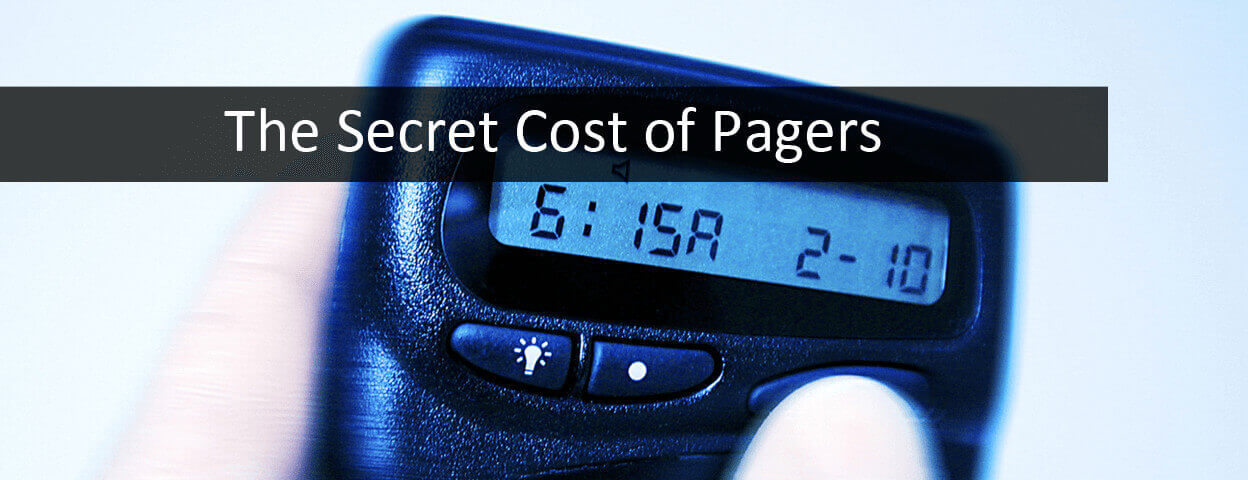Pager inefficiencies cost hospitals millions
Do you know how pager inefficiencies impact your hospital ?
Hospital paging system use reached its zenith in 1994. While pager use has dropped in the ensuing 23 years, cellphone use by physicians has becomes near ubiquitous with recent findings showing that 91% of physicians owned a smartphone and 88% used their mobile devices frequently in the clinical setting. Seeing these statistics juxtaposed, one cannot help but wonder why healthcare continues to use pagers over smartphones given the dangers that pagers pose.
Healthcare continues its use of pagers in large part based on misconceptions about the limits of smartphones. The goal of this blog is to highlight and explain the costs associated with continued. pager use. These costs are not just the immediate financial ones although pager inefficiencies have been estimated at $8.3 billion annually . These costs also extend to the costs such as security vulnerabilities and workflow slowdowns that result from using pagers.
Cost of using aging technology
Unlike fine wine, technology does not get better with age. The technology which pagers are running on is for the most part legacy technology which has an aging infrastructure. As there are fewer institutions relying on pagers each year, there is less incentive every year for carriers to provide network updates. Yet relying on it has simply become the cost of doing business for many hospitals. They feel it is too expensive to abort the paging technology in favor of an updated mechanism.
Workflow cost highlights pager inefficiencies
Given the lack of immediacy pagers provide, they inevitably delay communications. Physicians don’t know if a sent page was actually delivered, received or if the recipient has read the message. There is no mechanism for pagers to provide this information either. The back and forth required to remedy this lack of knowledge hurts workflow and has a cost.
In addition to wasted time, pagers also have a negative impact on the quality of patient care. Many physicians view pagers as disruptive. Studies have shown that during a typical call shift, as the volume of pages increased, many ceased to respond to the urgency of the alerts. However, when physicians did respond, it often took more than 10 minutes. It became evident that increasing pager workload had adverse effects on patient care.
HIPAA violation
One of the biggest problems with pagers is that they present the opportunity for a HIPAA violation when used to exchange patient data. While simple exchanges of phone numbers or room numbers on pagers are not HIPAA violations, any exchange of personal patient information could represent a violation. As one journal noted, messages containing protected health information (PHI) would be impermissible under the HIPAA Security Rule (Security Rule) unless the covered entity either removed PHI from the message or complied with the Security Rule’s administrative, physical and technical safeguard requirements. However, making messages this circumspect truly limits the effectiveness of the message in the first place.
The cost of HIPAA violations can also be seen through the amount institutions are fined for violations. On average, fines range from $100 to $50,000.However, in 2016, the largest of these fines was over $5 million dollars for exposing the personal health data of over 4 million individuals.
Hospitals can no longer assume they will fall through the cracks and not be the victim of one of these fines. Even if the hospital does not suffer financial repercussions, the public shaming that comes with admitting to a potential HIPAA violation can have significant consequences to a facility’s reputation. Hospital who continue to use pagers are playing a game of Russian roulette.
Conclusion
The costs of insecure pagers extend far beyond the potential of passing insecure information. They extend to HIPAA fines, hacked information, cybertheft and patient lives. When pagers are compromised, health and health records are also compromised.
However, there are secure texting and messaging platforms that provide a robust platform for healthcare messaging. These represent the best method for doctors, nurses and healthcare institutions to communicate. Individual providers and institutions need to investigate and begin adopting these platforms to ensure their patients and the healthcare community they serve.
To read more about the secret costs of pagers, download our whitepaper.






